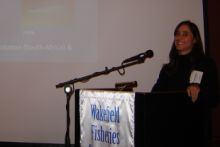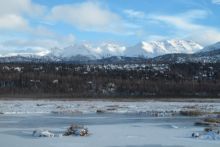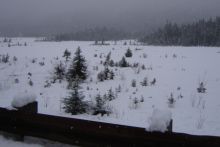Assessing global progress on ecosystem-based fisheries management
|
The word “Alaska” conjures up images of glacial ice-bergs cascading into turquoise oceans, snow-capped mountains cutting into azure skies and grizzly bears effortlessly flicking fat salmon onto the river banks, casually observed by an impressive antler-adorned moose ... and this image is indeed not far from the reality of beautiful Alaska.
However, the onset of white-out blizzards, avalanche threats and frozen seas during the winter months is a small hindrance to being able to fully experience the wilds of Alaska. And November in Alaska is truly the onset of winter. An opportunity to even glimpse this incredible landscape is, however, never to be turned down, even in the darkest of winter months. Neither is the opportunity to encounter, engage and learn from Northern hemisphere fisheries managers and researchers.
And so, with funding awards from the Knowledge, Interchange and Collaboration (KIC) Grant (National Research Foundation) and the Alaska Sea Grant, I set off in November to traverse the 16 844 km journey (about as close to the opposite side of the globe as one can get from Cape Town) to attend and present a paper at the 26th Lowell Wakefield Fisheries Symposium in Anchorage Alaska titled: Ecosystems 2010: Global Progress on Ecosystem-based Fisheries Management.
The Lowell Wakefield Fisheries Symposium series have been running since 1982 and are named in honour of Lowell Wakefield (1909-1977) who is regarded as the founder of the Alaskan king crab fishery, also proclaimed as the world’s most dangerous profession due to the cold, high winds and rough seas off the Aleutian Islands. Wakefield, an astute businessman but also a man who was in tune with nature, recognised that for the fishery to thrive, top quality seafood products were essential and that sustainable resource management must be based on the best available scientific data.
Focus on sound management of commercially harvested marine species
Since its inception, the Wakefield symposium series have addressed a wide range of subjects focussing on better understanding and sound management of commercially harvested marine species with topics including biology, ecology, economics, genetics, stock assessment, management and climate change. Building on the 16th Wakefield symposium held in 1998, themed ‘Ecosystem Consideration in Fisheries Management’, it was considered timely to evaluate the progress made in implementing an ecosystem approach to fisheries management in 2010.
With 120 participants representing 19 countries gathered in Anchorage (along with the onset of the first notable snowfall of the season, 18 cm), the main aims of the symposium were set out to evaluate global progress towards implementing the ecosystem approach to fisheries (EAF) and to offer explicit advice towards future progress.
The symposium started off on a snow-covered, below-zero Monday morning with a thought-provoking keynote address from Dr Howard Browman from the Institute of Marine Research in Norway. Dr Browman recapped the origins on the ecosystem approach, highlighted relevant international commitments and suggested a ‘back to basics solutions’ concept. The symposium was divided into four sessions — Progress on Regional Applications; New Tools and Ecosystem Indicators; Human Dimensions; and Case Studies.
Dr Chris O’Brien, the regional coordinator for the Bay of Bengal Large Marine Ecosystem project, placed global EAF issues into context by providing some facts about this project which spans the oceans between India and Indonesia, involves eight countries, covers a total area of 6.2 million km2 and affects 450 million of some of the world’s poorest coastal dwelling people.
Jenny Nord from the Swedish Board of Fisheries introduced a project initiated in 2009 called FISKE2020, which aims to reconstruct fishing stocks and ecosystem function by restoring and protecting areas and endangered species. Three primary concepts were discussed —development of fishery ecosystem plans, incentive-based approaches to management and introduction of the ‘LOPT’ system which, simply stated, implies harvesting of fish only once they reach an ‘optimal length’ which would be species dependent.
I presented a research paper that addresses some gaps in EAF previously identified in southern Africa. My work detected two ecosystem shifts in demersal (dwelling at or near the bottom of a body of water) fish assemblages on the west coast of South Africa over the past 24 years, using both multivariate and regime shift analysis tools. My presentation was favourably received with several delegates requesting additional information and follow-up discussions.
Arctic Zero catch option
Several North American and Canadian fishery managers outlined the various management approaches adopted to integrate multi-disciplinary elements and EAF in different counties or states, most of which appear to be underpinned by a similar triad of drivers, namely exploitation, trophodynamics (the dynamics of nutrition or metabolism) and biophysical/oceanographic. The broad similarities in approach were encouraging.
It was also highlighted that at present, the Arctic region is the only marine ecosystem where no large-scale fishing activity occurs and that this provides an ideal opportunity to implement ecosystem-based fisheries management (EBFM) from the outset. There is currently a ban in place that prevents development of any commercial fishery in the Arctic region, a decision resulting from a comprehensive assessment that concluded a ‘zero catch’ option to be both economically and environmentally beneficial.
Several presenters introduced new modelling studies based on food-web trophodynamics that have been developed to track indicators or changes in marine ecosystems retrospectively and into the future. Trevor Branch of the University of Washington presented his paper (recently published in ‘Nature’) which suggests that the widely used mean trophic level (MTL) indicator of fishery health is showing an increasing trend over time, contrary to earlier convictions that we are fishing down the food web.
The value of indigenous knowledge in marine fisheries
The Human Dimensions session certainly introduced many new dimensions of incorporating human components into marine ecosystems with a clear consensus that the human interaction element is the only one that can truly be managed in an ecosystem and that ignoring this element in EBFM would be fatal to sustainable management.
Several programmes in which the human dimension is being incorporated in EBFM were presented ranging from Japan, Australia, Estonia, Taiwan, USA and Canada. There is a strong developing focus on preserving and increasing the value of local and traditional knowledge in marine fisheries, illustrated by the example of how locals know exactly when and where the salmon will enter the rivers each season.
Johann Augustyn, representing the Benguela Current Commission (BCC), was the only other southern African delegate at the symposium and presented the implementation of EAF in the Benguela. It was once again extremely encouraging to note that between the Benguela Ecology Programme (1981-1996), BENEFIT (1997-2006), BCLME (2002-2007) and the newly implemented BCC, southern Africa features strongly with the global forerunners in successful implementation of EBFM.
Kwame Koranteng from the Food and Agriculture Organisation (FAO) reiterated that the BCLME program was FAO’s first attempt to implement EBFM and that the success of this programme has led to several other regional EBFM projects.
The symposium wrapped up with a panel discussion focussing on the necessary steps for future progress in EBFM with some pertinent broad perspectives being presented. After the two South Africans were acknowledged as having travelled the furthest of all delegates, the symposium was closed.
All papers presented at this symposium will be published towards the end of 2011 as part of the freely available online Wakefield publications (http://seagrant.uaf.edu/conferences/wakefield/proceedings.html)
With brains saturated with an astonishing diversity of acronyms, new knowledge on EBFM and warnings of not to approach any friendly moose we may encounter in the city too closely (I kid you not!), many of us who had travelled great distances spilt out into the melting snow and ice to finally explore the town and surroundings of Anchorage. One and a half days is simply not enough for anything in Alaska .... but I packed in as much as I could. I managed to catch a gap in the clouds for a spectacular sunset light show at 4 pm, a trip to the wildlife conservation centre where they rehabilitate wild animals, a drive along Turnagain Arm inlet to view snow-capped mountains and even a quick whizz on a snow-mobile through fluffy, thick, pure white snow.
The cuisine was nothing short of spectacular and I thoroughly enjoyed as many different types of local seafood as I could, guilt-free, because Alaskan fisheries are currently considered the best managed fisheries in the world! This ranged from seafood chowder, halibut burgers and clams to fresh wild-caught salmon and crab legs, all truly memorable.
Sadly, all too soon it was time to enjoy the last meal and the last glimpse of Anchorage and head out to the airport to begin my two-day journey home ... but once again, Alaska did not disappoint with a fresh snow storm starting up while I waited for my flight.
With new inspiration, new contacts from around the world and refreshed enthusiasm to aim for our own “guilt-free seafood feast” someday, I made my way back to sunny South Africa to share many ideas, information and contacts with my colleagues back home.
If anyone is interested in any particular component of the symposium outlined above, please feel free to contact me for more detailed, specific information. I would like to thank SAEON, the NRF and Alaska Sea Grant for making this experience possible.














